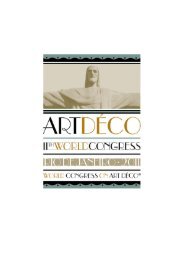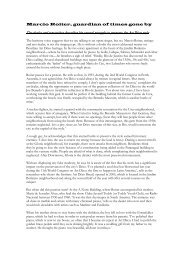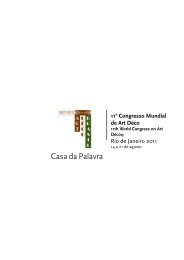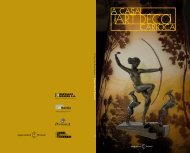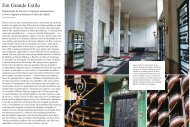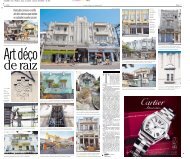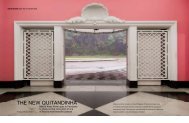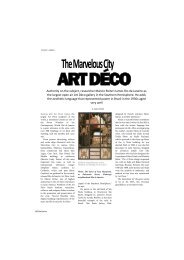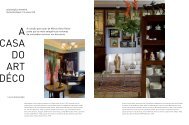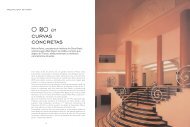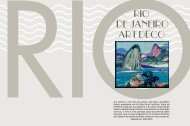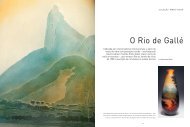Untitled - Instituto Art Deco Brasil
Untitled - Instituto Art Deco Brasil
Untitled - Instituto Art Deco Brasil
You also want an ePaper? Increase the reach of your titles
YUMPU automatically turns print PDFs into web optimized ePapers that Google loves.
French charm by the sea<br />
The Biarritz Building, on Flamengo Beach, still is an icon of art déco, a style that embellished Rio de Janeiro during<br />
the 20th century<br />
By EVA JOORY<br />
Produced by MÁRCIO ROITER<br />
Photos by RÔMULO FIALDINI<br />
WALKING THROUGH LARGE CITIES LIKE SÃO PAULO and Rio de Janeiro, it is easy to notice French<br />
architectonic style present in some of the buildings at both metropolises. Lost in the urban chaos and among a<br />
new aesthetic not as glamorous nor as adapted to the new era, some buildings still maintain the glamour of a past<br />
when Brazil celebrated its visual beauty and absolute prosperity. One of the most beautiful examples of buildings<br />
of French origin is the Biarritz Building, on 268, Flamengo Beach, still a déco icon in Rio. Giving credibility to<br />
that statement is antiques dealer Marcio Roiter, to whom the Biarritz “was able to adapt the French art déco style<br />
from the 1920s to the needs of a building in a tropical city—from the thickness of the walls, controlling the heat,<br />
to the awnings installed since the beginning, to the balcony-shaped verandas that create a natural barrier to street<br />
sounds.”<br />
The Biarritz is a design by the French duo Henri Paul Pierre Sajous and Auguste Rendu. It dates from 1940.<br />
There are 22 apartments distributed through its 12 stories, with different floor plans. The largest ones have 270<br />
squared meters; the smallest, 180. French influence over Brazilian architecture started in 1816 with the arrival of<br />
the French Mission to the country and lasted until the Second World War. There were four distinct styles: neoclassic,<br />
eclectic, art déco or art nouveau and modern. The different styles brought to Brazil more than a glamorous<br />
and luxury aesthetic. It brought a way to live well. The constructions were divided into completely independent<br />
wings—sleeping quarters, living rooms, and service areas, imitating the European style of dwelling.<br />
With this aesthetic, the Biarritz attracted famous dwellers, like Percival Farquhar, a controversial businessman<br />
who lived in the building’s penthouse. The home that once belonged to the couple known as Lucia & Harry, representatives<br />
of the American cinema that hosted many actors and directors who came to Rio between 1950 and 1970,<br />
is also there, occupying a duplex in the building.<br />
A great admirer of the Biarritz’s architecture, Roiter lists the details that add personality and charm to the building:<br />
“Light streamlined touches, the choice of noble materials, such as marble, wrought-iron with details in bronze,<br />
hardwood, grand mirrors and, above all, the idea that the biggest luxury is the sensation of open spaces”. Time, according<br />
to Roiter, never left its mark on the building. “Biarritz is an isolate example of a building that aged gracefully,”<br />
he praises.



